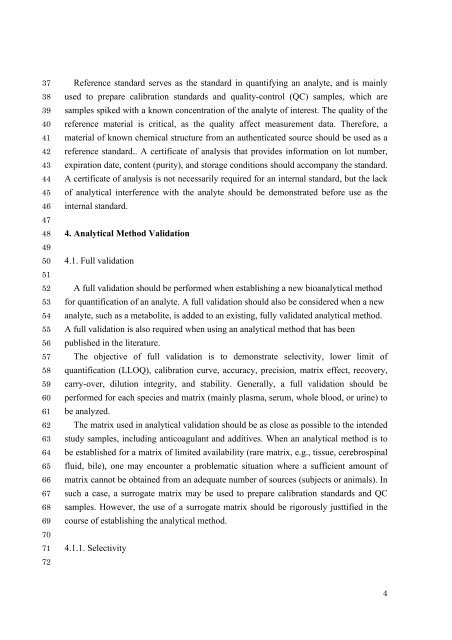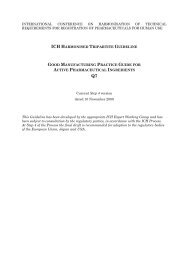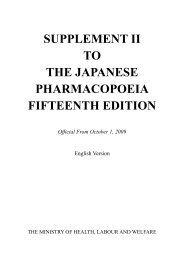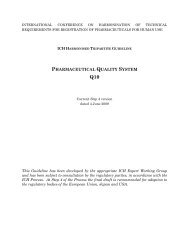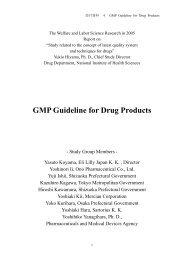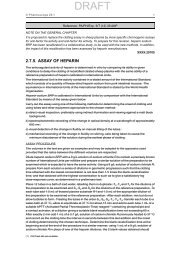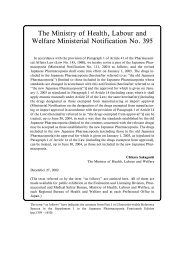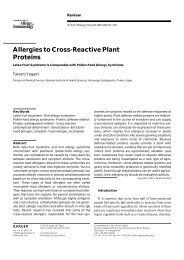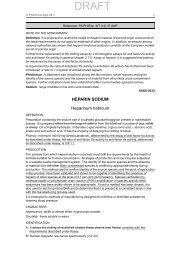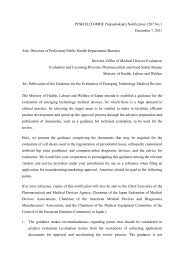Draft Guideline on Bioanalytical Method Validation in ... - NIHS
Draft Guideline on Bioanalytical Method Validation in ... - NIHS
Draft Guideline on Bioanalytical Method Validation in ... - NIHS
Create successful ePaper yourself
Turn your PDF publications into a flip-book with our unique Google optimized e-Paper software.
37<br />
38<br />
39<br />
40<br />
41<br />
42<br />
43<br />
44<br />
45<br />
46<br />
47<br />
48<br />
49<br />
50<br />
51<br />
52<br />
53<br />
54<br />
55<br />
56<br />
57<br />
58<br />
59<br />
60<br />
61<br />
62<br />
63<br />
64<br />
65<br />
66<br />
67<br />
68<br />
69<br />
70<br />
71<br />
72<br />
Reference standard serves as the standard <strong>in</strong> quantify<strong>in</strong>g an analyte, and is ma<strong>in</strong>ly<br />
used to prepare calibrati<strong>on</strong> standards and quality-c<strong>on</strong>trol (QC) samples, which are<br />
samples spiked with a known c<strong>on</strong>centrati<strong>on</strong> of the analyte of <strong>in</strong>terest. The quality of the<br />
reference material is critical, as the quality affect measurement data. Therefore, a<br />
material of known chemical structure from an authenticated source should be used as a<br />
reference standard.. A certificate of analysis that provides <strong>in</strong>formati<strong>on</strong> <strong>on</strong> lot number,<br />
expirati<strong>on</strong> date, c<strong>on</strong>tent (purity), and storage c<strong>on</strong>diti<strong>on</strong>s should accompany the standard.<br />
A certificate of analysis is not necessarily required for an <strong>in</strong>ternal standard, but the lack<br />
of analytical <strong>in</strong>terference with the analyte should be dem<strong>on</strong>strated before use as the<br />
<strong>in</strong>ternal standard.<br />
4. Analytical <strong>Method</strong> Validati<strong>on</strong><br />
4.1. Full validati<strong>on</strong><br />
A full validati<strong>on</strong> should be performed when establish<strong>in</strong>g a new bioanalytical method<br />
for quantificati<strong>on</strong> of an analyte. A full validati<strong>on</strong> should also be c<strong>on</strong>sidered when a new<br />
analyte, such as a metabolite, is added to an exist<strong>in</strong>g, fully validated analytical method.<br />
A full validati<strong>on</strong> is also required when us<strong>in</strong>g an analytical method that has been<br />
published <strong>in</strong> the literature.<br />
The objective of full validati<strong>on</strong> is to dem<strong>on</strong>strate selectivity, lower limit of<br />
quantificati<strong>on</strong> (LLOQ), calibrati<strong>on</strong> curve, accuracy, precisi<strong>on</strong>, matrix effect, recovery,<br />
carry-over, diluti<strong>on</strong> <strong>in</strong>tegrity, and stability. Generally, a full validati<strong>on</strong> should be<br />
performed for each species and matrix (ma<strong>in</strong>ly plasma, serum, whole blood, or ur<strong>in</strong>e) to<br />
be analyzed.<br />
The matrix used <strong>in</strong> analytical validati<strong>on</strong> should be as close as possible to the <strong>in</strong>tended<br />
study samples, <strong>in</strong>clud<strong>in</strong>g anticoagulant and additives. When an analytical method is to<br />
be established for a matrix of limited availability (rare matrix, e.g., tissue, cerebrosp<strong>in</strong>al<br />
fluid, bile), <strong>on</strong>e may encounter a problematic situati<strong>on</strong> where a sufficient amount of<br />
matrix cannot be obta<strong>in</strong>ed from an adequate number of sources (subjects or animals). In<br />
such a case, a surrogate matrix may be used to prepare calibrati<strong>on</strong> standards and QC<br />
samples. However, the use of a surrogate matrix should be rigorously justtified <strong>in</strong> the<br />
course of establish<strong>in</strong>g the analytical method.<br />
4.1.1. Selectivity<br />
4


